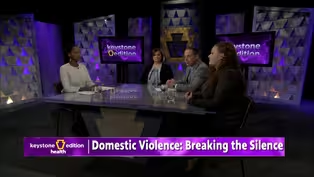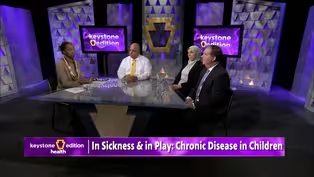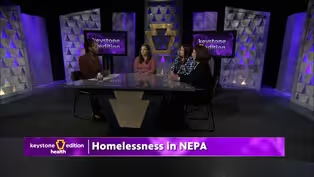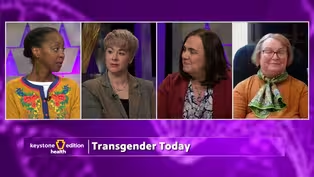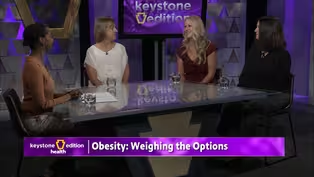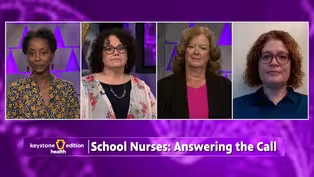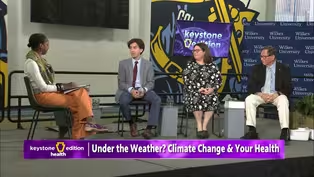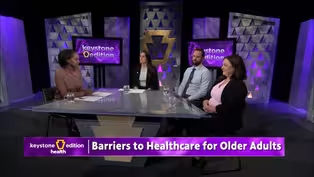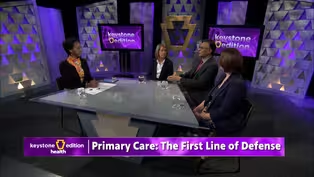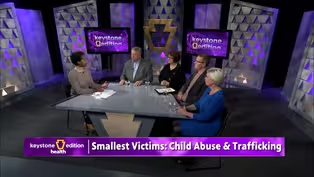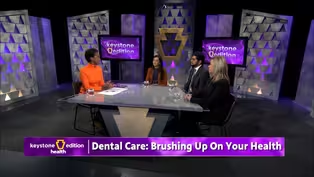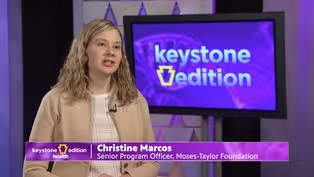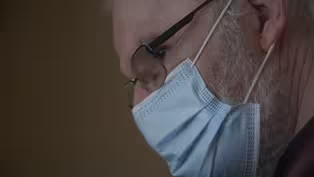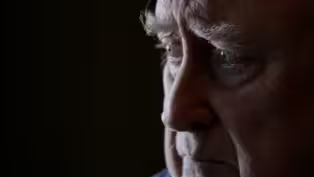Keystone Edition
Older Adult Isolation
12/27/2021 | 26m 58sVideo has Closed Captions
Nearly 40% of seniors living in NEPA are living alone
Nearly 40% of seniors living in North East, PA are living alone and the lack of social connections often leads to loneliness. They are more likely to face issues such as loss of family or friends, chronic illness, vision or hearing loss. Pandemic shutdowns in 2020 have only exacerbated such isolation, but local organizations in Lackawanna County have come together to address this issue
Problems playing video? | Closed Captioning Feedback
Problems playing video? | Closed Captioning Feedback
Keystone Edition is a local public television program presented by WVIA
Keystone Edition
Older Adult Isolation
12/27/2021 | 26m 58sVideo has Closed Captions
Nearly 40% of seniors living in North East, PA are living alone and the lack of social connections often leads to loneliness. They are more likely to face issues such as loss of family or friends, chronic illness, vision or hearing loss. Pandemic shutdowns in 2020 have only exacerbated such isolation, but local organizations in Lackawanna County have come together to address this issue
Problems playing video? | Closed Captioning Feedback
How to Watch Keystone Edition
Keystone Edition is available to stream on pbs.org and the free PBS App, available on iPhone, Apple TV, Android TV, Android smartphones, Amazon Fire TV, Amazon Fire Tablet, Roku, Samsung Smart TV, and Vizio.
Providing Support for PBS.org
Learn Moreabout PBS online sponsorshipMore from This Collection
Healthcare is constantly changing as technology finds new and better ways to help people live longer, healthier lives. Host Tonyehn Verkitus will address the issues that are important to the people in our community, including the ongoing pandemic, concerns about vaccines, food deserts, childhood trauma and child abuse, mental health, environmental issues, and the rising cost of staying healthy wit
Domestic Violence: Breaking the Silence
Video has Closed Captions
Access to the right resources can make facing this challenge a little easier for families (26m 59s)
In Sickness and in Play: Chronic Disease in Children
Video has Closed Captions
About 25% of children in the US aged 2 to 8 years have a chronic health condition (27m)
Video has Closed Captions
Homelessness can happen to anyone at any age or socio-economic status. (26m 59s)
Video has Closed Captions
As we raise the visibility on Transgender young adults and embrace them within our culture (26m 59s)
Video has Closed Captions
Obesity is a serious risk factor many try to avoid when developing healthy eating habits. (27m)
School Nurses: Answering the Call
Video has Closed Captions
What can our school districts do to help retain and recruit nurses for future generations? (27m)
Under the Weather? Climate Change & Your Health
Video has Closed Captions
How does climate change impact individual and public health? (54m 59s)
Barriers to Healthcare of Older Adults
Video has Closed Captions
What progress have local organizations made in addressing these challenges? (27m)
Primary Care: The First Line of Defense
Video has Closed Captions
When was the last time you saw your primary care doctor? (27m)
The Smallest Victims: Child Abuse & Trafficking
Video has Closed Captions
What are the signs to know to spot child abuse and even possible trafficking? (27m)
Dental Care: Brushing Up on Your Health
Video has Closed Captions
How can providers make dental care more affordable and accessible? (26m 59s)
Video has Closed Captions
What does the cannabis industry mean for Northeastern and Central Pennsylvania? (26m 59s)
Providing Support for PBS.org
Learn Moreabout PBS online sponsorship- [Announcer] Live from your Public Media Studios, WVIA presents Keystone Edition Health.
A Public Affairs program that goes beyond the headlines to address issues in Northeastern and Central Pennsylvania.
This is Keystone Edition Health, and now moderator Tonyehn Verkitus.
- Good evening, and welcome to Keystone Edition Health.
I'm Tonyehn Verkitus, thank you for joining us.
Tonight we will discuss the isolation facing many older adults in Northeastern Pennsylvania, and what local organizations are doing to help.
Have questions?
Call 1-800-326-9842, email keystone@wvia.org, or use #keystonehealth on social media.
First, let's hear from WVIA's Paul Lazar.
(air whooshing) - [Paul] Living alone is a reality for nearly 40% of older adults in Northeastern, Pennsylvania.
Older adults with a lack of social connections can experience loneliness and are more likely to face health issues such as chronic illness, vision, or hearing loss on their own.
When pandemic shutdowns exacerbated this issue in 2020, the Moses Taylor Foundation started gathering local organizations like the United Way, the Lackawanna County Area Agency on Aging and a host of others to reduce older adult isolation by identifying isolated older adults, connecting them with social programs and spreading awareness throughout the community.
For Keystone Edition Health, I'm Paul Lazar.
(upbeat music) - Joining us tonight we have Jason Kavulich director of Lackawanna County Area Agency on Aging.
Gary Drapek, president and CEO of the United Way of Lackawanna and Wayne counties also joins us in the studio.
And with us via Zoom is Teri Ooms, executive director of the Institute for Public Policy and Development.
Thank you all for joining us.
If you have a question for one of our guests, call 1-800-326-9842, email at keystone@wvia.org, or on social media, #keystoneeditionhealth.
Hi, thank you all for being here.
- [Guests] Thank you.
- Gary, can you give us just a little bit of background on this older adult isolation program so we understand how long it's been in the making and just generally what it's about?
- [Gary] Sure, well in all reality, the whole problem of older adult isolation I think has been talked about in our community and in our region for a very long time.
There are many agencies that have been working, like Jason's being one of them, that have been working, you know, separately I guess you would say to try to address this issue.
Back in, I think it was the late summer of 2019, Moses Taylor Foundation put out a request for proposal and asked organizations in the area to apply for a grant to put a plan together to address this situation within our region.
Soon after that happened we were approached, we being the United Way, by a group of organizations, Area Agency on Aging being one of them, the Wright Center being one, I think Penn State was involved at that time, and ask if we would take a lead role and actually apply for that grant and start pulling everything together.
We applied for the grant.
We received the grant and notification in November, December of 2019.
We had our first big meeting at the Hilton in early February of 2020, and then the world exploded, (chuckles) which brings us to today.
- For more on this collaboration, we spoke with Christine Marcos, program officer for the Moses Taylor Foundation.
(wind swooshes) - So in 2018, the Moses Taylor Foundation began a strategic planning process to identify some specific initiatives where we could really move the needle on some health issues in our community, and older adults were a population of particular concern to our board.
And at the same time we were seeing nationally a lot of research coming out about the health impacts of isolation.
In 2019, we issued a planning RFP grant looking for a collaborative who could work to create a system to reduce older adult isolation in Lakawanna County.
And since that time, we've worked with that collaborative which is led by the United Way of Lackawanna and Wayne counties serving as a partner and a resource for them as they work on this plan and eventually a pilot to reduce older adult isolation.
In addition to the Moses Taylor Foundation, we're really happy that we've brought a collaborative piece into the funding process of this as well, because we think it's really important for this to be a whole community-wide solution.
So the Scranton Area Community Foundation and the NDPA Healthcare Foundation has contributed towards the pilot.
And there are several other funders who are also currently reviewing requests.
So we're really happy to have that collaborative piece throughout our community.
(calming music ends) - Jason, given the work that you're doing at the Area Agency on Aging, what made you feel like a program like this was needed for the community?
- Well, the Area Agency on Aging has really always addressed isolation.
We didn't call it older adult isolation.
We didn't have a specific plan, but we did that primarily through our senior center network.
So senior centers exist for that purpose to bring people together, to help them be socialized with their peers and in their community, but also to serve as a nutritional avenue for them to make sure that if they need to, they have a hot meal every day.
So we have been working on isolation for a number of years.
This is just taking the data and taking information that's been gathered over the last few years and putting it to work with our partners in the community, which has helped us make a far bigger impact on the older adult population than we would if we were doing it as a standalone agency.
- Terry, I understand that at the Institute you did a needs assessment.
How did you develop the needs assessment and what exactly were you looking for?
- Well, there've been actually several needs assessments along the way.
We started working with the Moses Taylor Foundation in 2018 when they identified senior isolation as a strategic priority.
We were able to provide them with secondary data showing that there was a challenge with more older adults living on their own, more older adults in general as we have an older population in Northeastern, Pennsylvania compared to other regions.
So we started out with a full day retreat if you will, inviting community organizations to talk with us and our peers about senior isolation, what they were experiencing when they worked with clients, what needs they saw, where the barriers were, and that really laid the foundation for the first set of data and help the foundation adopt this as a priority, and then make the planning grant available for a collaborative to take it to the next level.
And then through that planning process, several other needs assessments were put into place because as we approach research, we look at a 360 degree view to assess a problem, and the cohort we all want to serve our senior citizens.
So there was a very lengthy process of engaging seniors in the discussion to find out more about their needs, what they would like to see, and how they would like to participate in a program that could help them.
- Now, I'm sure Jason, that you probably speak to seniors quite a bit, but was there anything out of this needs assessment that was surprising?
- [Jason] I don't think there was anything that really shocked us, but again, the important thing that we did in this process was engage directly with older adults, and talk to them about what they thought should be the solution.
And I think oftentimes we brush past that and think that we know what's best as professionals and as service organizations that we can tackle this problem.
So their feedback to me was the most important and one of the most valuable things that we took away, and that really helped us pave the path that we're going to go down in the future as we program out and address what they're telling us what we need to address.
- Gary, when you and I spoke, we talked a little bit about this, that whole idea of developing programs that don't work and then we wonder why.
What sorts of things are you hoping that this program will achieve that maybe have not been done for older adults before?
- Well, I think both with what Teri and Jason had said is so very true.
I mean, during the process, we at the United Way, we're able to hold a number of focus groups where we actually brought seniors into our conference rooms and talk to them about the programs, what they need, what they saw, any gaps in services and what have you.
For us I think it was a little bit of an eye-opener in that we have so many services that are available out in this community that seniors and older adults just don't really know about, or they don't know how to access those programs.
As Jason said, a lot of these programs have been around for a very long time.
This process, this collaborative, which is really amazing, I think the biggest part of it, the story behind the story is the collaborative are pulling all of these services together in one location to help older adults, and not only older adults but their caregivers, to get, you know, one phone call, one resource where they'll be able to get services for them.
- Even if they aren't living alone, older adults can experience isolation due to health issues.
We met Stuart and Sharon Dietz at their home in Dixon City where Stuart's health keeps him at home almost every day.
(wind swooshes) (gentle music) - [Stuart] There was time for sure when I was actually afraid to go out in like the stores and stuff like that.
There's too many people and I would hyperventilate a little bit, but then I just got used to it, and now I can go outside.
- [Sharon] He goes out only to doctor's appointments and testing.
I go out, I do my shopping, I don't have it delivered, like I do all that.
(gentle music) But my boys, they don't really check in on him like I guess they should or even check to see, you know, if he needs anything or we need anything.
So we're kinda basically on our own.
(gentle music) - [Stuart] I play board games, racing games.
I have 50 of X-Box One games, and 50 X-Box 360.
(gentle music) For being 64 years old, everybody says, "You play what?"
(chuckles) All my doctors get a kick out of it 'cause they know playing takes my mind off of things.
And you can see as I'm playing like the shaking starts to go away.
It helps a lot.
- [Sharon] It pre-occupies his mind.
- [Stuart] And it exercises it a lot.
(gentle music) Yeah, she definitely keeps on me.
If she see me getting low on myself, she gives me a boot in the butt, and let's go.
We just said that this morning we got each other and that means a lot.
- [Tonyehn] So what exactly does it mean to reduce isolation for older adults?
How do you see this program working for gentlemen like this?
- I think it needs to be flexible because it really has to meet an individual's needs.
It can't just be a wide sweeping program that this is what we're doing, and this is what's available to you.
No, it's gotta be more personal than that because everyone is a unique person.
Everyone is struggling with isolation in a different way.
There's people that can't leave their home that are isolated, but there's those that walk among us that spend time with us in the grocery store or in the bank they're isolated as well, we just don't realize it, and we don't realize what we're looking at.
So I believe that what the coalition and what the collaborative is working on is a way to meet an individual's needs and connect them so that they feel that warm handoff and that they know that they're being you know, treated as an individual, as a person, not just as part of a bigger program.
- I think if I could just add to that, and we have a terrible tendency of trying to fit everybody into the same box, not only with programs like this, but with a lot of what we do.
And this is actually a beginning of looking at individualized service.
I mean, isolation is different for different people.
And you know, we also have to respect the fact that there are many individuals out there who, for whatever reason, I mean, they want to remain in their home by themselves, and they want to be isolated.
We have to respect that as well, but we also have to be ready and available to have a program to help, you know, the individuals like that you just highlighted on there.
And I think the program that we're working on right now in the collaborative that we have going together is a huge leap forward in making that happen.
- [Tonyehn] Teri, part of the goal at the Institute is to make sure that your research is impacting programs positively.
How do you hope that you can help make this program sustainable as you do more research once it's put into play?
- Well, one of the things that's built into the program is an evaluative process.
So when the seniors enter the program and they take the short assessment, the assessment tells the case manager, the navigator, what sorts of barriers or challenges the individual is facing, what kinds of resources they may need access to.
And then it is up to that individual to get them in contact with the people that can provide those surfaces.
And so all of that data is going to be tracked over time.
And then, at different intervals, the senior will take that short assessment again, to see if there's any change.
And so we will be benchmarking an individual's change from the time they start the program through their evolution or participation within the program to note change.
And if it works like we think it will, we're going to find that we have seniors that are much more socially acclimated.
Perhaps their transportation needs are being met, they may have healthcare, mental health services that they didn't have before.
So it really starts to connect the dots between all of the resources that we have in the community.
And when you put them all together, that will lend itself to improve physical and mental health.
And in the long run, that preventative measure is not going to cost as much as it would to fixing problems after they occur.
And I think the data is going to demonstrate that.
So I think there'll be ongoing interest in funding from both nonprofit and even government agencies to keep this program and hopefully scale it so that we can really address all of the seniors in the region.
- Well, what this continued assessment, obviously we're hoping that preventative care happens sooner because hopefully you're recognizing issues before they become a problem, or someone's calling an ambulance.
But you did mention also that there are resources for caregivers.
So what types of resources would you be providing them with and do they access them through the navigator as well?
- Well, the ultimate goal, the ultimate hope as we move forward would be that caregivers as well as the individuals requiring the service would be obtaining those services through the navigator, that the navigator is going to be the key resource for this individual.
Again, a big, I don't want to call it a problem, but a big barrier that we have in front of us is actually getting this word out to the public and getting the entire community involved.
For example, I mean, in our discussions with our collaboratives, we talked about touch points, like what are the biggest touch points for seniors?
Obviously the physician's office.
We're hoping to get the medical community involved, to do a brief assessment on individuals, seniors, when they come in.
The bank teller, you know, the grocery store clerk, there are so many different touch points that individuals have.
And as far as services for caregivers, Area Agency on Aging has many different services that are available.
I don't wanna call them self-help services, but there are support services for individuals who are trying to provide that service to their aunt, uncle, mother, father.
- [Jason] And caregiving is probably the hardest and most challenging job someone can have.
Taking care of a loved one and providing for them really does impact that person in ways that, you know, we can't necessarily describe, but we do have our caregiver support program.
And we do offer the Arts for Life program, which is an alternative support group using arts to help the caregiver and the care recipient.
Plus we also have caregiver support groups for the caregiver and the care recipient at Telespond and the Wright Center.
In addition to that, that caregiver support group also does a support group for grandparents raising grandchildren, which is another unique situation happening in our community that we wanna make sure that we're working on and addressing, and it doesn't get talked about a whole lot.
So while there are all those caregivers resources that I just ran through really quickly, what Gary alluded to earlier is that people don't necessarily readily know about them.
A navigator system with an individual that you can reach out to, and they can help you connect, or at least walk through some of these services.
And in addition to care management services and the other services that have traditionally been offered in the community, we hope will help bring those individuals in and help make them more connected to what we all offer every day.
- If I could just add, and this is, I mean, obviously we didn't plan it this way, but the whole idea of older adult isolation has been such a quiet behind the scene, silent, and I hate to use the term silent killer because it's, you know, so used and abuse sometime, but it is a major cause of major health problems in seniors, and we see all the research.
There's one anecdotal research piece out there that says it's as dangerous as smoking 15 cigarettes a day.
Having said that, we recently over the past 18 to 24 months, all of us, each one of us have experienced isolation.
One of the, if you want to call it a positive fall out of COVID is that we've all been isolated so we now know what it's like to be a senior who's been isolated.
And try experiencing that 365 days of the year for a good portion of your life, especially when you don't wanna be.
So that's why we're hoping that we can get the entire community behind this project.
And your neighbor, for example, knock on the door, you know, go next door and see if your senior neighbors, okay, keep in touch with them.
That's also part of this program as well.
- [Tonyehn] Well, I've done some work with seniors, especially during COVID, and I have to admit it was a hard time trying to figure out how to collaborate with different organizations, bring the pieces together.
So in what you're doing, who are some of the collaborative partners that you really felt really needed to be in the room, and what are some underutilized resources that may now come into the forefront?
You named a few, but I'm just wondering if there's other.
- Well, the partners that we have in the room that I feel that are essential, are partners like United Neighborhood Centers and NeighborWorks, and of course, you know, the United Way who's spearheading this initiative.
They're seriously the key anchor partners in the human service world.
And then you have partners in healthcare, like the Wright Center that are coming along with us through this project and supporting us the entire way.
Other services like Telespond Day Services for Adult Day that people don't don't really utilize that service as often as they should.
It's an excellent service.
It's a medical based service in this community.
And we don't do a whole lot of talking about it and it's underutilized.
And therefore, when something's utilized, it's in danger of going away, but Adult Day provides one, relief for a caregiver, and two, it provides the care recipient a way out of the home, that they can go and socialize still, and they can spend time away and feel that sense of relief of not being in the same house all day long.
Plus the caregiver gets the opportunity to go out and be themselves.
Maybe it is just to go to the grocery store or get their hair done, but it's something.
And it gives them that that relief that they need so that they can keep moving on.
'Cause God knows if we didn't have caregivers doing this work, the systems would be completely overwhelmed.
- [Gary] I think one of the stories behind the story itself is you mentioned the collaborative partners and we have truly been fortunate and blessed.
When we started this program we had, I think, somewhere in the vicinity, Jason, 34 or 35 different organizations that came in as collaborative partners.
Then of course, February of 2020, COVID hit and everything stopped.
Stopped to the point where we you know, we were offered the opportunity for Moses Taylor to just like, let's stop the program.
Our lead partners Area Agency on Aging and the other 34 plus said, "No, we're going to keep going."
And we did throughout the lockdown period, we kept meeting by way of Zoom and really started it back up again in earnest in 2021, like in March of 2021, which brought us to the point where we are now.
So I've been doing this kind of work for a long, long time, I've never seen a group of that many organizations stay together for so long all for one cause.
So it's kind of heartening and it gives us a lot of faith that this program is gonna continue.
- Teri, I have one quick question for you.
We've touched on COVID and I'm just curious, were there any research that was done that may have brought about data that changed the trajectory of this program at all based on needs that you saw crop up during COVID?
- Yes, we have the opportunity to go out and visit with seniors over the summer to talk more about the program, to test the assessment, and to ask them how they would like to get the information, work through the system, and that type of thing.
And a lot of the seniors talked about the desire to learn more technology.
They didn't necessarily have computers or tablets or cell phones, but because of COVID felt that that was a lifeline that they wanted to learn those skills to be able to keep in contact with family, friends, to get information that they really would not have thought about prior to COVID.
- So, Gary, I guess the question we all want to know is when does the program kick off?
- [Gary] Well, we're beginning our pilot.
We wanna make sure that when we, you know, spread it out to the entire region or community, that it is as perfect as it can be.
So we are going to kick off a pilot in February with a select group of individuals.
We're going to run that through for about a year, and then we're going to kick it off after that year.
During that year period of time, we're obviously going to tweak it, you know, see what works, what doesn't work.
Through our focus groups we've been able to put together an advisory panel which is made up of seniors themselves who will be telling us how we can change it and how we can make it better.
So it officially begins, the slow start is going to be February.
The big start will be next year.
- [Tonyehn] And do folks contact you, your agency if they're interested in participating or do they have to wait for the pilot to be completed?
- We're going to do the no wrong door approach to this.
So I think they can access this program through several places, not just the Area Agency on Aging or the United Way.
We want people to find their way to us so that we can help them.
So calling any of the human service agencies that we're involved with, even if you are a recipient of Meals on Wheels, and you say it to your person that visits you and delivers your meal every day, we'll get connected to you.
We wanna make it just that easy.
- And with the eventuality of, and also another option is 211.
Calling 211, asking for information on older adult isolation, and you will be directed in the right direction.
- And is this only for Lackawanna County?
- As of right now, it is just Lackawanna County.
Hopefully as we move well into the future, we'll be able to broaden this for the region.
- [Tonyehn] And if others wanted to replicate this program, could they contact you at the United Way?
- [Gary] Most definitely.
We would be more than happy to talk to any other groups or communities who would like to replicate.
- And Terry, do you have anything that you'd like to share in closing?
We're going to be wrapping up shortly.
- Yes, I think this is an incredible testament to the organizations in Lackawanna County that have invested their time and energy in pulling together this program, because what is going to do is help connect the dots for the seniors to make it easier for them to get access to all of the resources and services that are available.
And I think this kind of regional effort, it's unprecedented in this area.
So it's a very exciting time to go forward.
- I would like to thank all of our guests for joining us.
Thank you for watching, and have a great evening.
(gentle music)
A Collaborative Approach to Solving Older Adult Isolation
Video has Closed Captions
Clip: 12/27/2021 | 1m 23s | Christine Marcos from the Moses Taylor Foundation explains a major initiative in the works (1m 23s)
Video has Closed Captions
Clip: 12/27/2021 | 2m 2s | See how one person in our region handles isolation in his own way. (2m 2s)
Older Adult Isolation - Preview
Preview: 12/27/2021 | 30s | Watch Monday, December 27th at 7pm on WVIA TV (30s)
Providing Support for PBS.org
Learn Moreabout PBS online sponsorship
- News and Public Affairs

Top journalists deliver compelling original analysis of the hour's headlines.

- News and Public Affairs

FRONTLINE is investigative journalism that questions, explains and changes our world.












Support for PBS provided by:
Keystone Edition is a local public television program presented by WVIA
